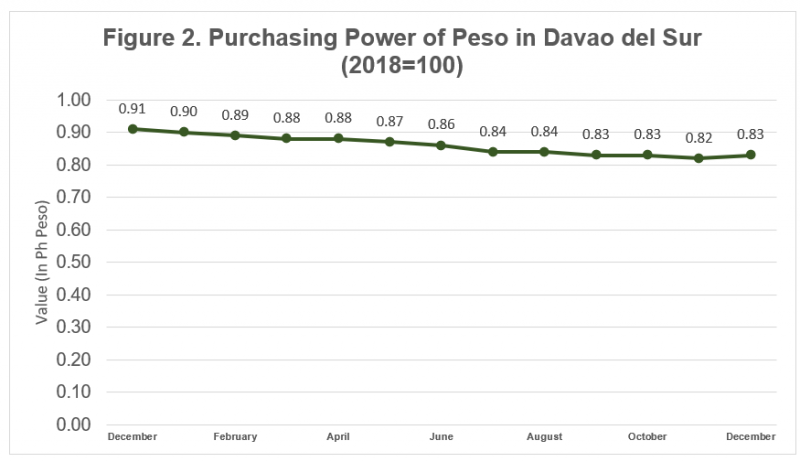

DAVAO DEL SUR
The headline inflation in Davao del Sur decreased by 1.6 percentage points having 9.8 in December 2022, from 11.4 percent in November 2022. This inflation rate is the fourth-highest recorded rate since January of the same year. The inflation in December 2021 was posted at 5.4 percent, which is lower by 4.4 percentage points than the recent inflation rate. The average inflation for the year’s eleven months stood at 8.0 percent (Table A and Figure 1).
The decrease in Davao del Sur’s inflation rate was mainly brought about by the decrease in the index for Food and Non-alcoholic Beverages at 12.5 percent. It was followed by the index for Housing, Water, Electricity, Gas and Other Fuels having 9.5 percent inflation. Then, Transport at 9.5 percent. Also, there is a decrease in the inflation rate in the indices of Alcoholic Beverages and Tobacco, and Furnishings, Household Equipment and Routine Household Maintenance at 14.5 percent, at 3.1 percent.
Meanwhile, the annual upticks of the following indices remained the same:
- Clothing and Footwear, 1.4 percent;
- Health, 4.9 percent;
- Information and Communication, 1.8 percent;
- Recreation, Sport, and Culture, 3.9 percent;
- Education Services, 0.3 percent;
- Restaurant and Accommodation Services, 7.1 percent;
- Financial Services, 0.0 percent; and
- Personal Care, and Miscellaneous Goods and Services, 2.0 percent.
The inflation rate of the food index also decreased by 3.6 percentage points having 13.1 percent in December 2022 from 16.7 percent in the previous month. In December 2021, the food index is 8.8 percent which is 4.3 percent lower compared to the recent inflation rate. (Table 9).
The inflation rate of Fish and Other Seafood decreased to 6.8 percent which is 12.0 percentage points lower than the previous month, this shares 63.0 percent which is the highest share of the food group’s inflation trend. Also, the annual growth rate of Corn under the food group Cereals decreased to 79.5 percent from 86.6 percent in the previous month, this shares 13.3 percent of the food group’s inflation trend which is the second-highest contribution. In addition, the inflation rate of Fruits and nuts decreased to 2.2 percent from 10.7 percent in the previous month, this shares 7.4 percent of the food group’s inflation trend which is the third highest contribution.
Furthermore, the following food groups also exhibited lower annual increments in December 2022 compared to the previous month:
- Rice, negative 2.6 percent;
- Meat and other parts of slaughtered land animals, 16.8 percent;
- Milk, other dairy products, and eggs, 2.6 percent;
- Vegetables, Tubers, Plantains, Cooking Bananas and Pulses, 16.9 percent;
- Sugar, Confectionery and Desserts, 34.7 percent; and
- Ready-made food and Other Food Products n.e.c., 4.0 percent.
On the other hand, the annual growth rate of Flour, Bread and Other Bakery Products, Pasta Products, And Other Cereals increased to 15.1 percent from 14.6 percent in the previous month. Additionally, there is also an increase in the inflation rate of the food group Oils and fats at 50.1 percent from 48.8 percent in the previous month.

In addition, the December 2022 Purchasing Power of Peso (PPP) in Davao del Sur is 0.83, which is 0.01 higher than the previous month’s PPP of 0.82. In December 2021, PPP is at 0.91. (Figure 2)

Technical Notes:
Consumer Price Index (CPI) - The CPI is an indicator of the change in the average retail prices of a fixed basket of goods and services commonly purchased by households relative to a base year.
Inflation Rate (IR) - The inflation rate is the annual rate of change, or the year-on-year change of the CPI expressed in percent. Inflation is interpreted in terms of the declining purchasing power of money.
Headline Inflation - measures changes in the cost of living based on movements in the prices of a specified basket of major commodities. It refers to the annual rate of change or the year-on-year change in the Consumer Price Index (CPI).
Purchasing Power of the Peso (PPP) - The purchasing power of the peso shows how much the peso in the base period is worth in the current period. It is computed as the reciprocal of the CPI for the period under review multiplied by 100.
